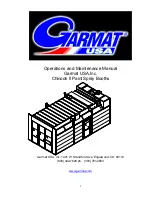
NCast Presentation Recorder Reference Manual
Receivers/Decoders of the stream, whether using a desktop player (QuickTime, Windows Media Player, etc.)
or a Presentation Recorder system, must have the ability to turn on/off the captioning features; thus the term
“closed”. Unfortunately, there is no fully standardized mechanism for captioning across these technologies.
Each media player handles captions differently.
QuickTime does not currently support industry standard closed caption such as ISMA. QuickTime currently
supports closed captioning by including a text track alongside audio and video content. QuickTime currently
supports two main methods of introducing captions, through .QT.TXT and .SMIL files. This URL provides an
overview of the QuickTime text track:
http://www.apple.com/education/accessibility/technology/quicktime_cc.html
The following sample .smil file launches a QuickTime player with a closed-caption text area:
<?xml version="1.0" encoding="UTF-8"?>
<smil xmlns:qt="http://www.apple.com/quicktime/resources/smilextensions"
xmlns="http://www.w3.org/TR/REC-smil" qt:time-slider="true">
<head>
<meta name="title" content="NCast PR-HD Series Commercial"/>
<meta name="author" content="VP Sales"/>
<meta name="copyright" content="NCast Corporation 2007"/>
<layout>
<root-layout height="285" width="330" background-color="black"/>
<region id="videoregion" left="5" height="240" width="320" top="5" background-
color="black"/>
<region id="textregion" left="5" height="40" width="320" top="245" background-
color="black"/>
</layout>
</head>
<body>
<par dur="0:03:14.10">
<video region="videoregion"
src="rtsp://www.ncast.com/archives/NCastCommercial320x240.mp4" dur="0:03:14.10"/>
<textstream region="textregion"
src="http://www.ncast.com/archives/NCastCommercial.en_US.qt.txt" dur="0:03:14.10"/>
</par>
</body>
</smil>
The .txt file used to play back the captions is shown here:
{QTtext}{timescale:100}{font:Arial}{size:12}{backColor:0,0,0}
{textColor:65535,65535,65535}{width:320}{justify:left}
[00:00:02.69]
Have you ever wanted to communicate with someone face-to-face?
[00:00:05.28]
To show them something, maybe a presentation or brochure?
[00:00:08.44]
But they were far away.
[00:00:10.00]
You could call them, but audio alone is not enough.
[00:00:13.00]
You could video-conference,
[00:00:15.00]
but that lacks graphics and only works for small audiences.
[00:00:18.07]
You could get on a plane, or you could telepresent.
NCast Corporation
Revision 2.2
Page 91
















































